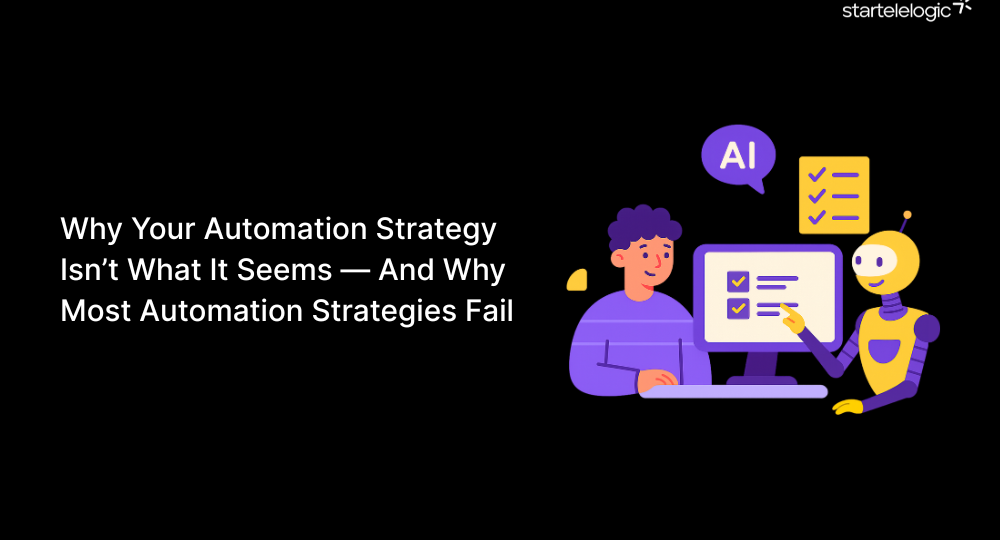You’ve invested in automation — the tools are in place, workflows are streamlined, and dashboards look impressive. But here’s why most automation strategies fail: what looks good on the surface often hides deeper issues.
Deadlines are slipping. Your team is burning out. That promised boost in efficiency? Still missing.
The real problem isn’t the technology — it’s the assumptions your strategy is built on. Assumptions about how people work, what should be automated, and what success really means.
On paper, your strategy seems solid. In practice, it might be quietly holding your business back. Let’s dig into the real reasons behind these failures — and how to fix them.
The Illusion of a ‘Working’ Automation Strategy
Sometimes we confuse being busy with being productive. Just because automation is running doesn’t mean it’s helping.
Many teams assume:
“We’ve automated it — so it’s fixed.”
“The system is running — so it must be working.”
But that’s not always true. You might be automating a bad process, skipping over real problems, or making things more complicated without actually improving anything. On the outside, everything looks smooth — but underneath, things might be stuck or even getting worse.
Good automation isn’t about doing more. It’s about doing the right things in a better way. And that only happens when you step back, question what you’ve built, and make sure it’s truly solving the problems that matter.
Why Most Automation Strategies Fail
Here’s the reality: automation doesn’t magically solve inefficiency. In fact, it can amplify existing problems.
Let’s look at the most common reasons automation efforts fall apart:
1. Automating Broken Processes
Automating a process that’s already inefficient or poorly designed won’t solve the problem — it just makes the same issues happen faster. For example, if a manual approval process is slow because of unclear rules, automation will only speed up confusion. Before jumping into automation, take the time to review and fix the process itself. Make sure it actually works well before you try to make it run faster.
2. No Clear Business Purpose
A common mistake is automating tasks just because they’re easy, not because they’re important. This can lead to wasted time and money with little impact. Every automation effort should be clearly connected to a business goal — like reducing costs, speeding up customer service, or improving accuracy. If you can’t measure how automation helps the business, it’s probably not the right task to automate.
3. Automating Too Much Without Human Input
Not every task should be fully automated. When companies try to remove humans from every step, they often lose important judgment, creativity, and flexibility. For example, an automated system might process a refund instantly — but miss signs of fraud that a human would catch. The best systems combine automation with human oversight, especially where decisions are complex or sensitive.
4. Too Many Tools, Not Enough Strategy
Using many automation tools — like RPA bots, low-code apps, AI platforms, and dashboards — can create confusion if there’s no clear plan behind them. Teams may duplicate efforts, struggle with integration, or waste time managing tools instead of solving problems. A successful automation strategy starts with understanding the business needs, then choosing the right tools to support them — not the other way around.
5. “Set It and Forget It” Doesn’t Work
Automation isn’t something you do once and walk away from. Processes change, business needs evolve, and tools require maintenance. Without regular monitoring and updates, automated systems can fail silently — or keep running in ways that no longer make sense. Make automation part of a continuous improvement cycle: check performance, gather feedback, and adjust regularly to stay aligned with your goals.
Signs Your Automation Strategy Isn’t What It Seems
1. Good Metrics, But No Real Business Impact
Your dashboards may show improved speed or efficiency, but if there’s no noticeable benefit to customers, revenue, or cost savings, the automation isn’t doing what it should. Numbers alone don’t equal success.
2. Manual Workarounds Are Still Common
If your team is frequently bypassing the system or creating extra steps to get things done, it’s a clear sign the automation isn’t fully solving the problem. A well-designed system should reduce — not shift — manual effort.
3. Costs Are Outweighing the Benefits
You may have invested heavily in automation tools, licenses, and consulting — but if those costs aren’t balanced by measurable savings or productivity gains, the strategy needs a rethink.
4. Processes Have Become More Complicated
Automation should simplify workflows. If your team now deals with more steps, integrations, or exceptions than before, you’ve added complexity instead of reducing it — which often leads to confusion and delays.
5. Low Team Engagement and Frustration
When employees feel like automation was “done to them” instead of “built with them,” they often disengage. If there’s resistance, confusion, or a lack of trust in the new systems, that’s a strong indicator something’s gone wrong in implementation.
Common Myths That Hurt Automation Success
Despite the growing adoption of automation across industries, several misconceptions continue to limit its effectiveness. Addressing these myths is essential to ensure that automation delivers real value rather than creating new challenges.
Myth 1: “Automation Equals Efficiency”
While automation has the potential to improve efficiency, this only holds true when applied to the right processes. Simply automating a task does not guarantee better results — especially if the underlying process is poorly designed. In such cases, automation may accelerate errors and inefficiencies instead of eliminating them. True efficiency comes from automating tasks that are well-defined, repetitive, and aligned with business goals.
Myth 2: “Once a Process Is Automated, It’s Solved”
Automation should not be viewed as a one-time fix. A common pitfall is assuming that automating a process eliminates the need for further evaluation or improvement. In reality, processes evolve over time, and what works today may not remain effective tomorrow. Continuous monitoring, feedback, and refinement are critical to ensure that automated workflows remain aligned with business needs and performance expectations.
Myth 3: “The More Tools We Use, the Better the Outcome”
The availability of numerous automation tools — from robotic process automation (RPA) to AI-driven platforms — has led many organizations to adopt multiple solutions simultaneously. However, without a cohesive strategy, this often results in fragmentation, duplicated efforts, and increased complexity. Success in automation depends less on the number of tools in use and more on how well they are integrated into a thoughtful, business-driven approach.
How to Fix a Failing Automation Strategy
Automation has the potential to drive real business value — but only when it’s used intentionally. If you’re automating without direction, you might just be making bad processes faster. Here’s how to shift gears and create impact:
1. Audit Your Current Workflows
Start by reviewing what’s currently being automated and why. Ask yourself:
- Are these true bottlenecks?
- Do these processes align with strategic business goals?
If the answer is unclear, it’s time to reassess priorities.
2. Track Real Business Outcomes
Don’t just measure the number of tasks automated or bots deployed. Focus on metrics that matter:
- Time saved
- Cost reductions
- Error rate improvements
- Customer satisfaction gains
Tie automation efforts directly to these KPIs.
3. Prioritize the Human Element
Talk to the people involved in these processes. Understand:
- Where automation is helping
- Where it’s causing friction
- Where human input remains essential
Empower your team to shape how automation is implemented.
4. Simplify Before You Automate
If a process is broken or bloated, automating it won’t help. Look to eliminate unnecessary steps and streamline before introducing automation. Simpler systems are easier to maintain, scale, and optimize.
5. Create Continuous Feedback Loops
Automation isn’t a one-and-done fix. Build a habit of:
- Reviewing performance regularly
- Collecting feedback from users
- Adapting and refining solutions
This ensures your automation stays relevant and valuable over time.
Conclusion: Is Your Automation Strategy Lying to You?
It’s easy to fall into the trap of thinking your automation strategy is working just because tasks are running, tools are integrated, and reports look clean. But automation is not a finish line — it’s a mirror. It reflects the quality of the processes, thinking, and decisions behind it.
The uncomfortable truth is: most automation strategies fail because they focus on doing more, faster — without asking whether those things are even worth doing. They rely too heavily on technology while ignoring the human insight, strategic clarity, and operational discipline required for sustainable impact.
Ask yourself:
- Are we automating for convenience, or for real business outcomes?
- Are our teams empowered and aligned — or bypassed and overwhelmed?
- Are we tracking success by real-world improvements, or just system activity?
If your automation strategy can’t answer those questions honestly, it’s not a strategy — it’s an illusion.
But here’s the good news: this is fixable. And if you’re reading this, you’re already one step ahead. By re-centering your automation around purpose, process, and people, you can build a system that truly works for you, not the other way around.
Don’t let automation become just another checkbox or cost center. Make it your competitive advantage — with clarity, strategy, and truth.
Frequently Asked Questions: Why Most Automation Strategies Fail
1. Why do most automation strategies fail?
Most automation strategies fail because they focus too heavily on tools instead of outcomes. Common issues include automating broken processes, lack of alignment with business goals, neglecting human input, and a “set-it-and-forget-it” mindset. Without a clear strategy and continuous evaluation, automation often scales inefficiency instead of eliminating it.
2. How can I tell if my automation strategy is failing?
Warning signs include growing complexity, unclear ROI, manual workarounds by your team, or a disconnect between what’s automated and what actually drives business value. If you feel busy but not productive, your automation may be working against you — a common reason why most automation strategies fail.
3. What are the top mistakes businesses make with automation strategies?
Top mistakes include:
- Automating without understanding the underlying process
- Using too many tools without integration
- Failing to measure real results
- Ignoring employee input
- Overlooking long-term maintenance
These mistakes are central to why most automation strategies fail.
4. Can automation work without a clear strategy?
Rarely. Automation without a strategy often leads to wasted investment, increased complexity, and frustrated teams. This lack of direction is a key reason why most automation strategies fail — they prioritize implementation over intention.
5. What should a successful automation strategy include?
A successful strategy should:
- Align with business goals
- Involve all stakeholders
- Focus on process improvement first
- Include a clear measurement framework
- Adapt over time
Ignoring these factors is exactly why most automation strategies fail.
6. How can I avoid common automation strategy pitfalls?
Start with a process audit, define your goals clearly, involve your team, and don’t over-automate. Focus on outcomes, not just efficiency. Building flexibility and feedback loops into your system is essential to avoid the traps that explain why most automation strategies fail.




